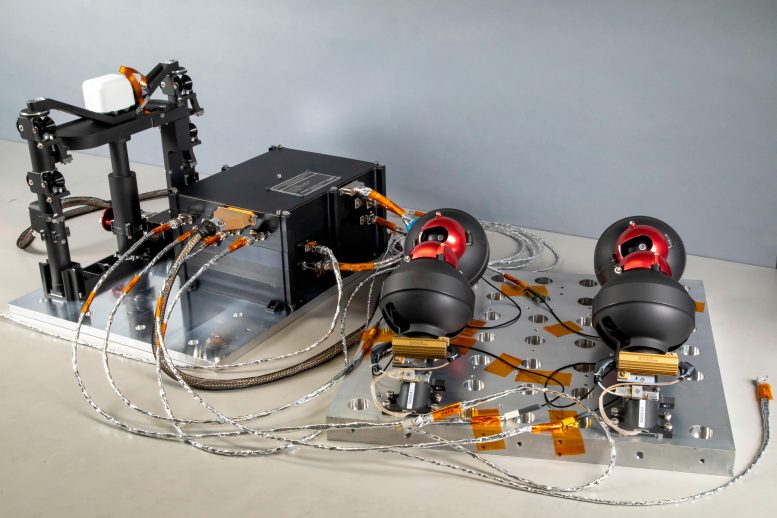
SwRI developed and delivered the LMS instrument for the Mare Crisium lander to find out {the electrical} conductivity of the inside of the Moon by measuring low-frequency electrical and magnetic fields. LMS consists of (from left) a magnetometer (white) on an extendable mast, a central electronics field and 4 spring-launched electrodes. Credit score: Southwest Analysis Institute
The LMS instrument will look at {the electrical} conductivity of the inside of the Moon.
The Southwest Analysis Institute lately delivered the Lunar Magnetotelluric Sounder (LMS) to Firefly Aerospace positioned in Cedar Park, Texas, for incorporation into the Blue Ghost lunar lander. The automobile is predicted to the touch down on the Moon in 2024. The LMS will consider {the electrical} conductivity of the Moon’s inside by analyzing low-frequency electrical and magnetic fields.
“For greater than 50 years, scientists have used magnetotelluric strategies, which use pure traits of the Earth’s electromagnetic fields to find out {the electrical} resistivity of the subsurface for analysis and useful resource exploration,” stated SwRI’s Bob Grimm, principal investigator of the instrument. “LMS would be the first extraterrestrial software of magnetotellurics.”

SwRI’s LMS instrument would be the first extraterrestrial software of magnetotellurics from aboard a lunar lander to Mare Crisium, an historical, 350-mile-diameter affect basin that subsequently full of lava. The basin is one among many giant darkish spots on the Moon’s floor seen to the bare eye. They have been dubbed lunar maria, Latin for “seas,” by early astronomers who mistook them for precise seas. Credit score: Lick Observatory
NASA’s Artemis program is a series of increasingly complex missions to build a sustained human presence on the Moon for decades to come. To support these goals, LMS is part of a 12-day lunar lander mission to help understand the Moon’s subsurface in a previously unexplored location. LMS is being funded and delivered to the lunar surface via NASA’s Commercial Lunar Payload Services (CLPS) initiative and is expected to land in Mare Crisium, an ancient, 350-mile-diameter impact basin on the Moon that subsequently filled with lava. It is a dark circular spot in the northeast region of the Moon’s nearside that stands apart from the large, connected areas of dark lava to the west of where most of the Apollo missions landed.
These vast, linked lava plains are now thought to be compositionally and structurally anomalous to the rest of the Moon. From its vantage point at Mare Crisium, LMS may provide the first geophysical measurements representative of the overall Moon.
Electromagnetic fields penetrate to greater depths with decreasing frequency, allowing LMS to probe the interior of the Moon to depths up to 700 miles or two-thirds of the lunar radius. The electrical conductivity depends on the temperature and composition of the materials traveling through the field. The measurements will shed light on the differentiation and thermal history of our Moon, a cornerstone to understanding the evolution of solid worlds.

